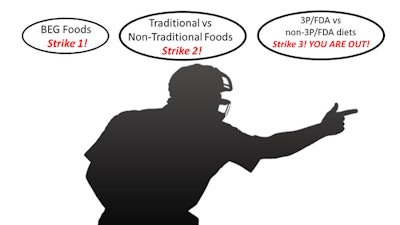
This may be a shocker to some, but the truth is, there is not a direct cause-and-effect link between canine dilated cardiomyopathy (DCM) and grain-free pet foods. In fact, there has never been a single research study to demonstrate the relationship; rather, the fact is: The association between DCM and grain-free foods has been weak at best.
DCM and grain-free pet food facts
It appears that some veterinarians, especially in academia, and even some of my colleagues in the pet food industry conveniently ignore that even the Food and Drug Administration (FDA) has acknowledged that DCM is a scientifically complex, multi-faceted issue. This is sad, considering that practicing veterinarians often do not have time to research the topic themselves and actually look to these experts for legitimate and truthful information.
Additionally, FDA acknowledged that out of the more than 2,000 cases investigated, only 1,100 could be confirmed as DCM (note: NOT nutritional DCM, as there are many types). Meaning, veterinarians were inaccurate in their diagnosis for 45% of the cases submitted to FDA versus other potential cardiac issues, such as heart murmurs. Lastly, FDA even noted that pulse ingredients have been used in pet food for a long time, and again, there is no evidence to indicate that they are inherently dangerous to dogs.
Also, many veterinarians conveniently ignore that DCM is the second most common heart disease affecting dogs, with prevalence greater than 50% in some breeds. In 2006, Sanderson estimated that the prevalence of DCM ranged from 0.5% to 1.1% in the overall population of dogs. Said differently, that means there would be 450,000 to 990,000 DCM cases in the current 90 million dogs living in the U.S. Assuming Sanderson’s estimate was indeed accurate, far more cases should have been reported to FDA based on the expected prevalence in the population of dogs in the U.S. today. Yet, most veterinarians I talk to have never seen a single case. Go figure!
I guess it’s just a US problem!
At what point do the leaders of this saga realize that many of the “problematic” foods are shipped worldwide? Unless other countries have a DCM vaccine, or the dogs there are immune to DCM, why doesn’t the problem exist outside of the U.S.?
For example, the recent Salmonella recall by Midwestern Pet Foods shed light on where their products are sold from the Monmouth, Illinois, manufacturing facility. This one plant resulted in contaminated products across eight Midwestern Pet Food brands, which were also shipped to 19 other countries.
Specifically, one of Midwestern’s most popular brands, Earthborn Holistic, is sold in the U.S. and 34 other countries. Ironically, Earthborn was tied for the fourth spot for dog food brands most frequently fed in reported DCM cases by FDA. Since this brand is clearly also shipped worldwide, where are the DCM grain-free cases in the rest of the world? I make this point because other countries have been laughing at the U.S. about this debacle and how long it has lasted.
Strike 3: Still no evidence to make a connection
Recently, a Tufts study funded by Nestlé Purina PetCare, “Investigation of diets associated with dilated cardiomyopathy in dogs using foodomics analysis,” is being touted in the popular press as identifying a “link” between certain dry pet foods and DCM. Although it makes good headlines, this couldn’t be farther from the truth. I studied and developed foods for Hill’s Pet Nutrition with traditional nutrient and chemistry screen analysis, genomics, proteomics and metabolomics over a decade ago before it was “sexy,” and I didn’t make up silly terms like “foodomics”, so a study like this is frustrating and sad to see. If anything, it just adds to the confusion and contributes nothing to the science of nutrition.
Although the terminology is being used today, in the Tufts study it is being misused. Simply performing metabolomics on a food is not “foodomics.” To understand why this important, you should know that metabolomics is the scientific study of the set of metabolites (chemical compounds) present within an organism, cell or tissue. It is not equivalent to food analysis or food forensic chemistry. “Foodomics” requires the combination of food chemistry, biological sciences and data analysis. Considering this, note that the Tufts study only looked at food chemistry via one analysis (metabolomics) and therefore does not fulfill the remainder of the definition of foodomics.
No validation of data in the Tufts DCM study
When looking at metabolomic data, people often forget that “fold changes” do not always equate to biological relevance. For some metabolites, a difference of 1X could be a big deal, while for others, a 5X may not be relevant. So, what do I mean? If the authors wanted to validate some of their conclusions for B vitamins, there are known Association of Official Analytical Chemists (AOAC)-approved B-vitamin analyses that could and should have been conducted to make this an actual “foodomics” study. If the authors had analyzed the B vitamins via traditional methods, they could have validated their theories of the fold changes observed via metabolomics.
They could have done the same with taurine, carnitine and other nutrients, which showed no differences in the foods via metabolomics. Again, they did not nor did they with other known nutrients that are easily measurable. Unfortunate, since this is supposed to be a “nutrition” paper written by “nutritionists.” It’s also unfortunate that this particular professor is likely damaging the reputation of her students before they even start their career due to her actions. Funnier still is the fact that the company that funded the study owns NP Analytical Laboratories, which specializes in vitamin and taurine analysis. So, it wasn’t due to a lack of funding.
In my opinion, the authors’ not connecting metabolomics and “foodomics” clearly demonstrates a lack of understanding and improper usage of metabolomic technology and use of the “foodomics” nomenclature. There is no excuse for not sending out for analyses of B vitamins, taurine, carnitine and other known nutrients. Especially when traditional nutrient analysis is inexpensive, and you already have the foods to be sent out for such analysis. Better yet, have the company that is funding you analyze the foods for you in their lab!
Lastly, metabolomics does not look for all compounds. That is why “foodomics” is a combination of various analyses in both foods and body versus just one single analysis. For example, would this method have identified melamine in the 2007 pet food recalls? No, because melamine is not a metabolite. Which goes back to my prior misuse of metabolomics statement. Would it have identified L-Ascorbyl-2-Polyphosphate (a heat-stable form of vitamin C known as Stay-C), which is the most used heat-stable source of Vitamin C in dry foods? No, because it shows up in the plasma as vitamin C. What about aflatoxins in their natural form? Also no.
Would many of the other compounds measured in the Tufts study be digested and absorbed as they are measured in the food? Also no, since metabolites present in food may go through chemical changes within the body during normal metabolism. I could go on, but you get the point: another huge miss for a “nutrition” paper written by “nutritionists.”
Limitations of the Tufts DCM study
When a paper has a “limitations of study” section longer than the abstract, that speaks volumes. It brings into question all of their data collection, analysis, results, conclusions and more. Some limitations of the study included:
- The selection of diets was based on ones associated with DCM and NOT diets directly linked to DCM. Thus, there is still no true connection, as the authors allude to in their abstract and their interviews with the popular press.
- When you choose pea-based foods versus not-pea-based foods, of course you will see a difference in the two groups. The study was literally designed to do this from the beginning. Duh! If the researchers would have used foods containing peas that were not associated with DCM in the FDA investigation, that could have been a third group that served as a control, along with the grain-inclusive pet foods. This is the classic garbage-in and garbage-out situation, where poor study design leads to improper conclusions and you know the outcome before you analyze the foods. It’s unfortunate that in many cases surrounding this DCM debacle, peer review has not served the purpose it was supposed to. Nor has common sense.
- Even the authors acknowledge, “Although informative, the individual selections and even the diet categories may not be the optimal categorization, and additional research will continue to add to the knowledge base to refine the design of future studies and clinical recommendations.” I don’t believe one of the authors was quoted saying that in the press, though I could be wrong.
- They further acknowledge, “Some of the diet samples were obtained directly from owners of dogs with DCM; most of these diets had been opened and stored for variable periods of time, first by the owner and then by the investigators, so this could introduce variability and could bias the 3P/FDA (3P = pulses, potatoes or sweet potatoes) diets in having lower levels of certain nutrients that could degrade as a result of variable storage conditions.” Do you think? Did I mention garbage in and garbage out? Simply put, this means that the metabolite profile of these foods could vary drastically once the outer packaging is open and oxidation/degradation has set in.
Vendetta against peas?
This study does not show anything nor eliminate anything. Especially when there is a lack of control foods, processing temps, known inclusion rates, improper use of technology, lack of validation of technology, lack of control in how products are sampled … I would keep going but my head hurts with all the flaws in the study.
Just imagine if certain “researchers” took their valuable time and money and chose to spend it more wisely on real research as they were taught to do in graduate school and as interns. The money would be better spent diagnosing the disease earlier, looking at genetics, titrating out ingredients for relationships and other things that make it real research. Clearly, certain groups have a lack of knowledge in formulation, and one would say nutrition as well, since they focus solely on ingredients and not on the underlying nutrition of the food. Me personally, I do not eat peas. I also do not have a vendetta against them, either.
Finally, at what point does the industry simply stop paying attention to this nonsense? First it was BEG (boutique, exotic, grain free), second it was traditional versus non-traditional diets and now 3P/FDA foods. As a fan of baseball, I think that makes 3 strikes!


















